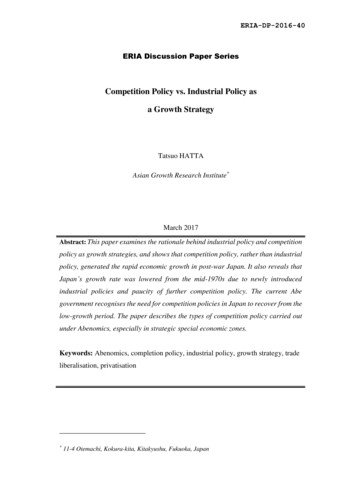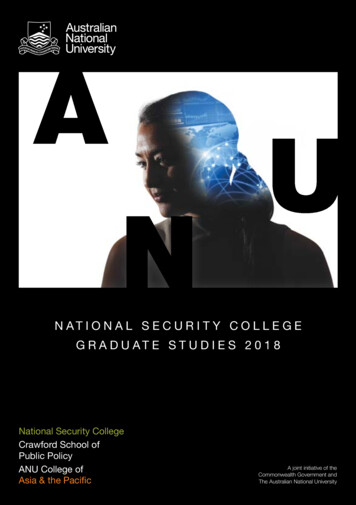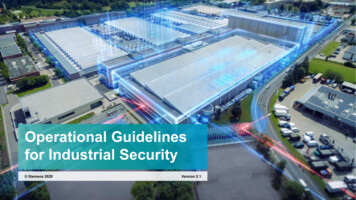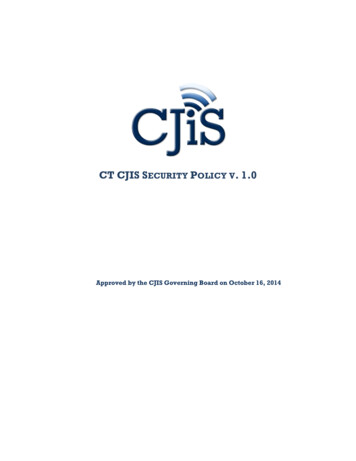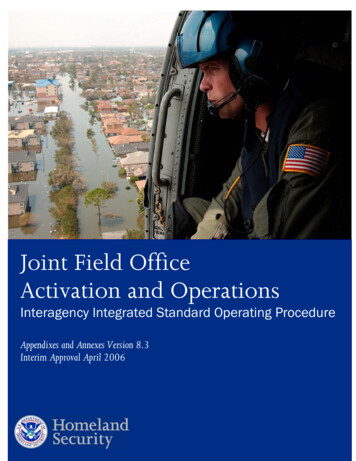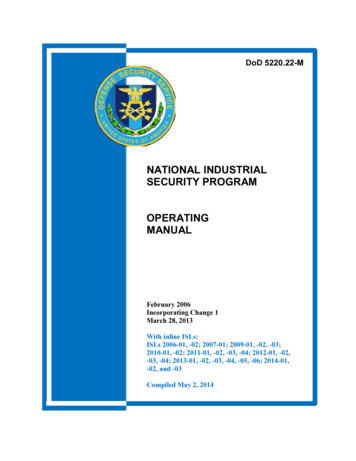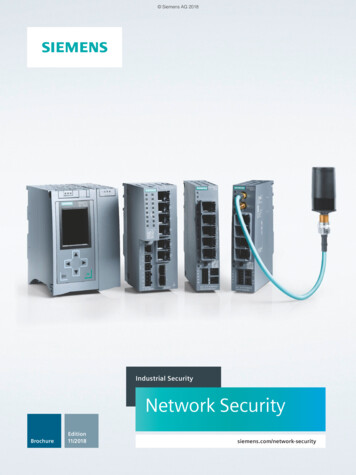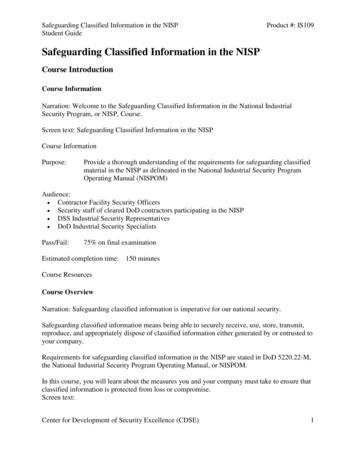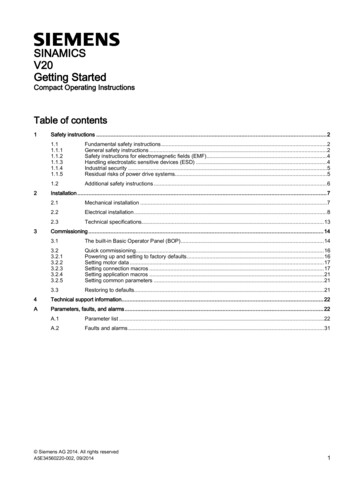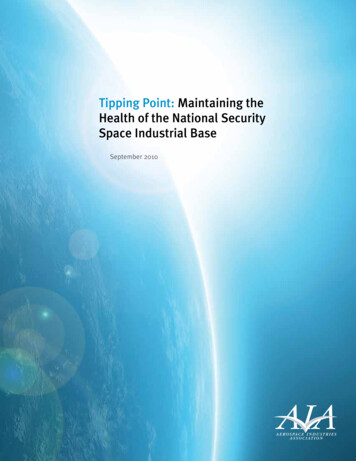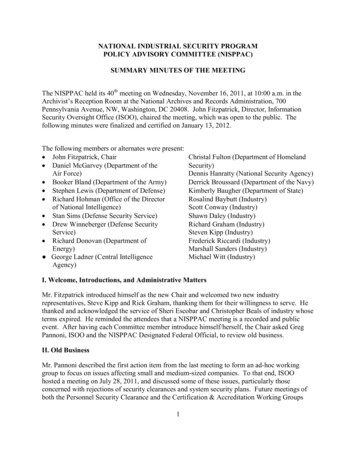
Transcription
NATIONAL INDUSTRIAL SECURITY PROGRAMPOLICY ADVISORY COMMITTEE (NISPPAC)SUMMARY MINUTES OF THE MEETINGThe NISPPAC held its 40th meeting on Wednesday, November 16, 2011, at 10:00 a.m. in theArchivist‟s Reception Room at the National Archives and Records Administration, 700Pennsylvania Avenue, NW, Washington, DC 20408. John Fitzpatrick, Director, InformationSecurity Oversight Office (ISOO), chaired the meeting, which was open to the public. Thefollowing minutes were finalized and certified on January 13, 2012.The following members or alternates were present:John Fitzpatrick, ChairDaniel McGarvey (Department of theAir Force)Booker Bland (Department of the Army)Stephen Lewis (Department of Defense)Richard Hohman (Office of the Directorof National Intelligence)Stan Sims (Defense Security Service)Drew Winneberger (Defense SecurityService)Richard Donovan (Department ofEnergy) George Ladner (Central IntelligenceAgency)Christal Fulton (Department of HomelandSecurity)Dennis Hanratty (National Security Agency)Derrick Broussard (Department of the Navy)Kimberly Baugher (Department of State)Rosalind Baybutt (Industry)Scott Conway (Industry)Shawn Daley (Industry)Richard Graham (Industry)Steven Kipp (Industry)Frederick Riccardi (Industry)Marshall Sanders (Industry)Michael Witt (Industry)I. Welcome, Introductions, and Administrative MattersMr. Fitzpatrick introduced himself as the new Chair and welcomed two new industryrepresentatives, Steve Kipp and Rick Graham, thanking them for their willingness to serve. Hethanked and acknowledged the service of Sheri Escobar and Christopher Beals of industry whoseterms expired. He reminded the attendees that a NISPPAC meeting is a recorded and publicevent. After having each Committee member introduce himself/herself, the Chair asked GregPannoni, ISOO and the NISPPAC Designated Federal Official, to review old business.II. Old BusinessMr. Pannoni described the first action item from the last meeting to form an ad-hoc workinggroup to focus on issues affecting small and medium-sized companies. To that end, ISOOhosted a meeting on July 28, 2011, and discussed some of these issues, particularly thoseconcerned with rejections of security clearances and system security plans. Future meetings ofboth the Personnel Security Clearance and the Certification & Accreditation Working Groups1
will continue to focus on these areas. Next, he described a request from the Department ofDefense (DoD) for an accounting of the number of remaining industry-operated non-GSAapproved security containers, and stated that DoD would provide an update during this meeting.He then reviewed a request for ISOO to coordinate a presentation on “The Governance of theInsider Threat.” He mentioned that the month of October 2011 saw the issuance of ExecutiveOrder 13587, “Structural Reforms to Improve the Security of Classified Networks and theResponsible Sharing and Safeguarding of Classified Information,” designed to improve thesecurity of classified networks as well as the responsible sharing and safeguarding of classifiedinformation. Further, that the new order focuses on, among other things, classified informationsystems, and prescribes minimum standards and guidance for the implementation of policygoverning insider threat programs. He posited that the Chair would briefly describe governingaspects of this order, and in a future NISPPAC meeting, would summarize guidance related toongoing developments in the insider threat program. Next, Mr. Pannoni alluded to a report ontrends relating to a decline in the submission of Phased Periodic Reinvestigations (PPR), andstated that representatives of the Security and Suitability Executive Agent‟s (SEA), PPRWorking Group would provide an update on continuing efforts to ensure consistency in theapplication of the PPR process. Finally, he described the last action item concerning theformation of an ad-hoc working group to address how appropriate threat data may beexpeditiously disseminated to National Industrial Security Program (NISP) facilities. Heexplained that ISOO had subsequently hosted a July 28, 2011 meeting to address these issues andto identify the pathway ahead. He also announced that DoD, in support of this initiative, willhost an all-day Threat Information Workshop at the Collaboration Center in Quantico, VA onDecember 1, 2011. Finally, he called for working group updates, and began with Randy Riley ofthe Defense Security Service (DSS).III. Working Group UpdatesA) Certification & Accreditation Working Group (CAWG) ReportMr. Riley presented an update (Attachment #1) of recent activity of the CAWG. He defined theprimary function of the Working Group as an examination of the processes for certifying andaccrediting information systems. He explained that DSS is the Designated Approval Authority(DAA) and the Cognizant Security Authority (CSA) on behalf of industry, and as such isresponsible for accrediting information systems. He emphasized several key points with regardto DAA‟s responsibilities in the certification and accreditation process, most notably that theprocess ensures that information system security controls are in place to limit the risk ofcompromising national security information, that they provide a structure to efficiently andeffectively manage a certification and accreditation process, and that the process ensuresadherence to national industrial security standards.Mr. Riley noted that the systems metrics data, covering the period October 2010 throughSeptember 2011, reflects continued improvement in the timelines for issuing Interim Approval toOperate (IATO) and Approval to Operate (ATO) certificates. With regard to System SecurityPlan (SSP) review metrics, the data continues to reflect that one third or more of all plansrequired changes prior to the on-site review, and about one fourth of the systems required some2
level of modification during the on-site verification process. The metrics identify thediscrepancies by facility category, which focuses attention on where problems are mostfrequently occurring. The findings suggest that a large percentage of these discrepancies aremore prevalent in smaller companies. These observations reflect systemic problems withinindustry that must be addressed both by the NISPPAC and the government in order to minimizethe number of rejections and to reduce the number of denials to an absolute minimum.Tim McQuiggan, Industry, inquired, in view of the fact that a 34 percent error rate isunacceptable, if there might be a way that companies at headquarters level could be apprised oftheir own data, so that if there are systemic issues within their organizations, they could begin toaddress them. Mr. Riley responded that such assistance could certainly be provided, perhapseven at the Commercial and Government Entity (CAGE) code level. He suggested that theWorking Group would discuss this issue and develop the particulars of precisely whatinformation should be provided. Stan Sims, DSS, pledged that the concept would certainlyreceive serious consideration and that DSS would report back to the NISPPAC with thefeasibility and scope of analysis by which the information might be provided. Mr. Riley addedthat the DAA would require that point of contact details be sent to the ODAA mailbox from allthose corporate entities wanting this information.Mr. Riley explained the differences between a denial and a rejection in the IATO process,defining a denial as acceptance of an SSP into the process, reviewing it, and then denyingissuance of accreditation, often due to such conditions as incorrect documentation, while arejection indicates that an SSP was so weak that it couldn‟t even be entered into the process,perhaps for such a condition as failure to attach the plan. Thus, DAA‟s primary goals are toreduce the number of denials and eliminate rejections. Further, industry is working efficiently toturn around the denials quickly, as this is often accomplished in two or three days.Next, Mr. Riley presented data concerning the on-site system validation which reflected thatapproximately two percent of the systems reviewed had significant problems that preventedimmediate issuance of an ATO. He described DAA‟s efforts in moving systems from IATO toATO status noting that the number of days to achieve ATO status has been significantly reduced.There followed a discussion of tracking initial issuance and/or second issuance of an IATO.Although these numbers are on a decidedly downward trend, DAA remains interested inidentifying and reducing them, especially the second IATO, because system accreditation cannotoccur while it exists. Tony Ingenito, National Classification Management Society (NCMS),inquired as to whether this process had been automated. Mr. Riley explained that the processelements for doing so were still in development, but expected to be completed by the end of FY2012. The plan is based on an online system wherein the facility Information System SecurityManager can submit the SSP without using e-mail. Once this action is completed, the plan‟ssteps can be tracked, so that everyone involved in the process knows the exact condition of theplan‟s development at each stage.The Chair then challenged the membership to take advantage of the work done by the variousworking groups, as their efforts enable both government and industry representatives to refine3
discussion on each of the topics and to raise new concerns. He placed special emphasis on theNISPPAC‟s need to work harmoniously with Congress, the Office of Management and Budget(OMB), and the intelligence community as each addresses continuous streamlining of thepersonal security clearance process. He then introduced the Personnel Security ClearanceWorking Group and asked that its representatives update the timeliness metrics for industryinvestigations.B) Personnel Security Clearance Working Group (PSCWG) ReportRepresenting the PSCWG were Lisa Loss, Office of Personnel Management (OPM), and HelmutHawkins, DSS. Ms. Loss‟s metrics presentation showed continued reductions at all levels inboth investigation and adjudication times for FY 2011 (Attachment #2). The Chair articulatedthat because the system does not always account for 100 percent of completed adjudication data,there is a gap between investigations completed and adjudications reported. Therefore themetrics can only reflect statistical accuracy to the degree that the information is reported to thesystem. The Chair requested that the Working Group evaluate how to close this gap so that wecan realize full confidence in the comprehensive nature of the data.Mr. Hawkins then reported metrics on pending initial investigations and renewals (periodicreinvestigations), both of which achieved completion time improvements (Attachment #3). Hefollowed with a depiction of the Defense Industrial Security Clearance Office‟s (DISCO)workload for the FY, and noted that these updated metrics more accurately reflect suspendedcases that DISCO has that pertain to supplemental investigations, special investigations, pendingsubject interviews, and reopening of other categories. Thus, the adjudication cannot becompleted until the additional required information is provided.Next, Mr. Hawkins briefed on industry cases pending at OPM, showing an FY reduction ofroughly three percent, followed by an illustration of the rejection rates at both DISCO and OPM.DISCO‟s rejection rate was approximately ten percent of all investigations submitted; OPM‟srejection rate was approximately five percent. He noted that one of the chief factors causing anOPM rejection was the non-receipt of fingerprint cards within the 30-day allotment which wasdecreased to 14 days, effective October, 2011. However he noted that a 14-day cutoff has longbeen the standard for all government agencies except for DoD, to include the NISP. Thus the14-day allotment is now being applied for everyone except for overseas investigations. Severalmeeting participants were unaware of this change and expressed concern that since the 30-daycutoff already results in numerous rejections, there is likely to be a further increase. Ms. Lossexplained that knowledge of the change was provided through the Background InvestigationsStakeholder Group (BISG), was posted on their website, and tracks back to the PerformanceMeasurement and Management Subcommittee that had sought to establish a standard of 14 daysfor the end-to-end process since it established the metrics. The Chair suggested that the WorkingGroup, along with representatives from OPM, the Undersecretary of Defense for Intelligence(OUSD(I)), and DSS, consult on this matter to determine the ultimate impact, and perhapspursue the development of an improved migration plan to meet the standard.4
Mr. Sims suggested that since DoD has a 2013 timeline to establish the transfer to electronicfingerprints, and more than 70 percent of the rejections are due to fingerprints not matching theinvestigative file, it would seem that we could adjust a change in that policy to coincide with therequirement for the electronic fingerprint process. The Chair suggested that we first understandthe impact of such a change prior to proceeding to the next steps, and that we remain within theconcerns of the NISPPAC, which is to understand and report that impact to the decision-makers.Further, he noted that as some of us have been the interlocutors for big customer and big serviceproviders negotiations, we must ensure that we be attentive, respectful, and informative to thatprocess, because if there is going to be a significant impact and if there is another path to betterperformance, we should surface that to those with this high level of interest.Mr. Hawkins next discussed DISCO case rejections by facility category, and noted that 81.4percent originate from the smaller facilities. He advised that 51 percent of all DISCO rejectionsresult from either missing employment information or inaccurate information on finances. Headded that every DISCO rejection results in an additional 25 to 30 days, and that every OPMrejection results in an additional 60 days for case completion.Finally, Mr. Hawkins‟ described the primary reasons for OPM rejections, namely missingfingerprint cards and certification/release issues. He noted that 91 percent of all OPM rejectionscome from one or both of these two categories. In response to the Chair‟s plea for anexplanation of the nature of certification/release issues, Laura Hickman, DISCO, described theprimary problem as missing certifications and/or unreadable signatures on release data. Finally,the Chair suggested that the Working Group include other investigative and adjudicativeinformation, such as the Defense Office of Hearings and Appeals (DOHA) statistics.C) Performance Accountability Council (PAC) ReportThe Chair called for a report from the Performance Accountability Council‟s (PAC) workinggroup on Phased Periodic Reinvestigations (PPR) to address the processes in place to affect theiruse and impact on clearances submitted under the NISP. He introduced Christy Wilder, Officeof the Director of National Security (ODNI), and re-introduced Ms. Loss.Ms. Loss informed the Committee that a PPR working group has been established to makerecommendations to the SEA for government-wide policy regarding at what point a PPR shouldconvert to a full Single-Scope Background Investigation (SSBI)-PR. In 2005, OPM met with theBISG, and established a set of “triggers” (essentially thresholds) that indicate the presence ofsecurity issues necessitating the expansion of the investigation to a full SSBI-PR. However,enough concerns about the validity of some triggers has since arisen that there have been tworevisions. Further, when OPM began working with the SEA, a new SF 86 that would meet thereform deliverables already committed to Congress was needed as well as standardization ofPPR triggers for the entire investigative community.Ms. Wilder then described how the ODNI‟s SEA Advisory Committee (SEAAC), composed ofvirtually all government agencies who maintain a personnel security program, OPM, the DefensePersonnel Security Research Center (PERSEREC), and DOHA, formed a Working Group to re5
evaluate and recommend triggers for PPR conversions (Attachment #4). As a result of theWorking Group‟s efforts, the SEA intends to issue a government-wide policy, perhaps as early asFebruary 2012, which, pending implementation of the revised Federal Investigative Standard(FIS), will be used by all Investigative Service Providers (ISP). The updated product is ready togo out for a 30-day comment period, and all agencies who participate in the SEAAC and theBISG will be asked to provide suggestions and/or recommendations. Ms. Wilder reminded theCommittee that the implementation date for the revised FIS is December 2013.IV. New BusinessA) Executive Order (E.O.) 13587The Chair presented a brief recap of the causes that provoked action, followed by a descriptionof the current executive branch posture, with regard to insider threat activity (Attachment #5).He began with a summary of the Fall 2010 events that led to realization of the need for a unifiedresponse to the problems inherent in the unauthorized disclosure of classified information,proceeded to the formation by the National Security Staff (NSS) of an interagency committee toreview the policies and practices for the handling of classified information, and concluded withan overview of E.O. 13587. He characterized this order as the beginning of a formal nationalresponse to the heightened activity caused by the WikiLeaks disclosures, which very carefullyprovides a governance structure for future policy and standardization to follow.He next explained how NSS and OMB launched a number of activities, among which was apolicy process to create the “to-do” lists for government. He described how the E.O. provides anew governance structure for improved security of our networks, while continuing emphasis onthe sharing of classified information. He stressed that these are companion goals, and that theyeach received significant emphasis throughout the process. He then defined the guidingprinciples governing proposed reforms: reinforcement of the importance of responsibleinformation sharing, ensuring that policies, processes, technical security solutions, oversight, andorganizational cultures match information sharing and safeguarding requirements, emphasizingconsistent guidance and implementation across the entire federal government, recognizing theimportance of shared risk and shared responsibility, and continuing to respect the privacy, civilrights, and civil liberties of the American people. This was all accomplished with theestablishment of some decision-making bodies and some guidance-providing bodies.He then described the uppermost of these bodies, the Senior Information Sharing andSafeguarding Steering Committee. This committee has overall responsibility for fullycoordinating interagency efforts and ensuring that departments and agencies are held accountablefor the implementation of information sharing and safeguarding policy and standards. (TheChair serves on this committee.) In addition, staff support for this committee comes from thenewly created Classified Information Sharing and Safeguarding Office (CISSO), which isadministered within the ODNI‟s program manager for Information Sharing Environment.CISSO is, a small staff function created to organize the work of the steering committee and toensure proper activity coordination, namely DoD and NSA who jointly are the Executive Agentfor Safeguarding Classified Information on Computer Networks.6
The new E.O. has also created an Insider Threat Task Force (ITTF), co-chaired by the AttorneyGeneral and the Director of National Intelligence (DNI). Its mission is to bring together thepractitioners to create national policy affecting improvements in identification from withinorganizations and systems users who have access to classified information, and a bettercharacterization of the threat that they may represent to that information and to those systems. Inpractice, the task force is co-chaired by the National Counterintelligence Executive (NCIX) andthe Federal Bureau of Investigation (FBI), and is supported with detailees and assignees fromacross its membership. Further, the new E.O. tasks the ITTF to establish national policy oninsider threat. The Chair correlated this activity with the objectives of the NISPPAC, in that itrepresents the interweaving of existing requirements for personnel security and informationsystems security, and will place increased emphasis on consistency, network-monitoring tools,and how these might trigger indicators that can be used to better protect classified information.The E.O. emphasizes that agencies have the primary responsibility for sharing and safeguardingclassified information. It leverages but does not change existing policy structure for classifiedinformation. Similar to E.O. 13526, it requires the designation of a senior agency official whowill be responsible for the implementation of the national policy on insider threat and thesafeguarding of classified information on computer networks. All of this activity is coordinatedand overseen by the steering committee and reports through the CISSO, placing renewedemphasis on existing requirements for agencies to self-inspect.The Chair noted that even though there is not yet an impact on policy or specific requirementsgoverning industry participants in the NISP, there will be specific guidance forthcoming. Aspolicies begin to emerge, they will be promulgated through the NISPOM. Since these policiesinvolve elements of both personnel security clearance processes and the safeguarding of networkprocesses that the NISPPAC already participates in, there will be actions for the NISPPAC asthis process matures. For example, the reporting of personal foreign travel and personal foreigncontacts today may evolve to performing those tasks perhaps in a different way or through a newprocess. What is less clear is the way that this policy will connect to classified enclaves operatedon contractor-owned versus government-owned networks. Currently, the emphasis in thesteering committee is on how to characterize and improve these capabilities on governmentowned networks. To the extent that industry has users on those networks, those users will fallunder the same umbrella as anybody else. Certainly there will be increased capabilities, but tothe degree that it may require additional capabilities to be borne on contractor-owned networksthat operate within these classified security domains, that‟s the space to watch and one of theprimary reasons that we‟re opening a dialogue on this topic today. So, perhaps the initial criticalquestion is at what point the voice of industry is needed in this policy development process.Finally the Chair asked to be kept informed of any questions, in particular on anythingCommittee members may have already heard about this, in terms of it levying requirements orother work. The Chair then asked Steve Lewis, OUSD(I) to provide the DoD update.B) DoD UpdateMr. Lewis gave the Executive Agent‟s (EA) report on the NISP, and addressed the status of theNISPOM re-write. He informed the Committee that within two days of E.O. 13587 being issued,7
DoD was receiving questions as to its applicability to industry. He assured the Committee thatas the implementing directives are written for this E.O., the Committee will closely evaluatethem, because E.O. 12829, as amended, “National Industrial Security Program” requires similarsecurity controls for industry to those applicable to government. Indeed, a keystone of E.O.13587 is the Committee on National Security Systems (CNSS) process for identifying securitycontrols in the information systems environment. The proposed revisions to Chapter 8 of theNISPOM make a similar reference to CNSS. Therefore, it‟s understood that as new federalpolicy is developed, that will translate into new NISPOM requirements.Regarding the NISPOM re-write, Mr. Lewis stated that later that day OUSD(I) would forward tothe NISPOM working group members an adjudicated comments matrix. This distribution willnot include Chapter 10 because of the extreme volume of comments on that chapter, norAppendix D, which is the NISPOM supplement, because there are still a few issues on which tocomplete our work. In addition, we‟ll be asking for “fall-on-your-sword-” type comments byDecember 2nd. These fall into the category of, “we agreed to do something in the working groupprocess and we didn‟t do it.” Also, violations of law and/or of government-wide regulation arethe types of things that would be reclama comments. He provided that the Working Group didnot always agree as they moved through this process, one that required over a year to complete,but we attained a much-improved product. For example, in Chapter 5, Section 3, “Storage andStorage Equipment,” we have provided an additional option for industry for the open storage ofclassified information, which is similar to options available to government agencies. He furtherexplained that DSS has prepared an Industrial Security Letter (ISL) which allows for immediateimplementation of those provisions for the approval of open storage areas, and that aftercoordinating the ISL with the other Cognizant Security Agencies (CSA) it will be distributed tothe NISPPAC members. In addition, Chapter 8, “Information System Security,” has beensignificantly improved. It has been streamlined, rendered much more flexible, and equippedwith a measure of control and opportunity for industry to input into the process.Mr. Lewis then moved to a brief description of several DoD initiatives as a result of mandatedrequirements. First, he addressed the issue of the Congressionally-directed action on securitycontainers, and he reminded the Committee that DoD must submit a report to Congress inJanuary, 2012 on the status of industry‟s discontinuing the use of non-GSA approved containersfor the storage of classified information. He described the progress to date using 2009 baselinenumbers in which industry had almost 13,000 non-GSA approved containers storing classified,contrasting that with the latest available numbers as reduced to 4,700, or roughly a 60-pluspercent reduction. He added that DoD believes that this number has since been further reduced,and that there is every indication that contractors will achieve the October 1, 2012 deadline foreliminating all remaining non–GSA approved containers.Next, Mr. Lewis presented brief reports on several ongoing DoD/NISP activities. First, hereminded the Committee that DoD was continuing to develop a Special Access Program (SAP)security manual. He emphasized that the goal of this initiative is that once issued within DoD wewill propose that it become the national level standard for contractors, that is, a “NISPSAP”manual. Then, he reported on DoD„s progress towards updating its activities‟ security policies,briefly describing two volumes of the DoD NISP manual in various stages of coordination. One,8
which will replace the 1985 industrial security regulation, contains the security requirements forgovernment activities and is close to being formally coordinated. The other is the ForeignOwnership Control and Influence (FOCI) procedures for government activities, which willimplement the existing directive-type memorandum, but on a more permanent basis. Finally, hedescribed some new requirements levied on DoD activities concerning the tracking of NationalInterest Determinations (NID). He explained that this guidance requires that each DoD activitydesignate an individual authorized to provide coordinated positions on FOCI and NID matters torespond to a DSS NID notification requirement within 30 days. That is, activities must provide aNID, submit a proposed NID, pending concurrence from another activity, or make thedetermination to deny the NID. Thus, companies cleared under special security agreements willat least receive a definitive answer. Also, the memorandum requires that DSS track the NIDprocess monthly. To that end, DoD received the first report from DSS yesterday.Brad Groters, public visitor, inquired as to the projected timeline for finalization of the revisedNISPOM, and when it will be posted in the Federal Register. Mr. Lewis responded thatDecember 2nd is the suspense date for final comments from the NISPPAC members, and we willthen follow with final changes. Therefore, within 60 days it will go to both a DoD coordination,and concurrently, coordination with the other CSAs.C) DSS UpdateThe Chair recognized Mr. Sims, who introduced Jim Kren as the new Deputy Director, DSS.Mr. Sims then reported that both DoD and industry stakeholders had already consulted on mostof the DSS implementation that Mr. Lewis described and that all had had clear, frank andproductive discussions, and are committed to a collaborative approach for addressing theseissues. He reiterated that in terms of the NID process, a lot of guidance has been issued to DoDparticipants, and that when included in the NISPOM, it will apply to all other governmentagencies that DoD provides industrial security services. He explained that DSS guidancecomplies with both the 30-day and 60-day NID national policy requirements, and that both DoDand other agencies who currently have outdated NIDs requests must address them within aspecified time period to comply with those same regulations. Then, we‟ll place an internalcontrol on monitoring all with outstanding NID requests, and subsequently provide a report tosenior leadership of the Under Secretary of Defense for Acquisition, Technology, and Logistics(OUSD(AT&L)) for the industry piece, and the OUSD(I) for the security piece, thus permittingprecise tracking of NID compliance. Also, he stated that DSS will coordinate with both theNational Sec
process ensures that information system security controls are in place to limit the risk of compromising national security information, that they provide a structure to efficiently and effectively manage a certification and accreditation process, and that the process ensures adherence to national industrial security standards.
